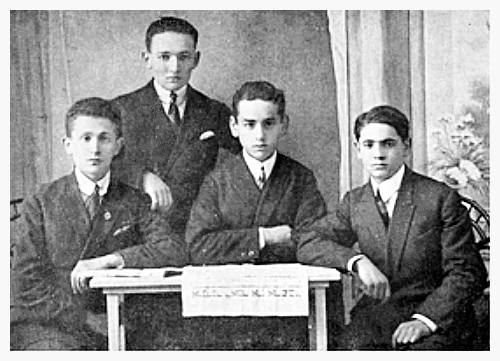
“The quartet”, who were among the founders of “HeChalutz” and S.Z.P. (“Tze'irei Zion”)
From right to left – A. B. Eisen, Yehuda Lieberman, M. Y. Schitenberg, Chaim Goldberg
|
by Hillel Fachter
Translated by Mira Eckhaus
The revisionist movement found its way to our city through Henrik Fireman from our city, who was then studying at the Gymnasium in Lodz. Beside him, at the head of the revisionist youth organization established in Radomsko, stood his friend Toshia Weinberg, the daughter of the well-known business photographer Ludwig Weinberg. These two organized a circle of Jewish youth, male and female students from the high schools in the city, who carried the idea of Jewish nationalism in their hearts. The members of the revisionist organization came mostly from homes with a nationalistic character, but there were also those who joined the movement without having any connection to Zionism. The revisionist youth circle that arose was very active, despite the limited number of its members.
The activities of the organization were versatile and encompassed the social, national and cultural area, as well as collecting funds for the foundations. In a short time, the organization became part of the national public activism in the city and became a significant and recognized factor in the life of the Jewish population.
Jabotinsky's visit to Częstochowa, in 1926, made a great impression on us. Our small group in Radomsko made great efforts to bring the leader of the movement to our city as well. When we realized that our efforts were in vain, all the members of the organization traveled to welcome Jabotinsky upon his arrival in the nearby city of Częstochowa and to hear his speech there. We were not the only ones who traveled; Many from near and far accompanied us, veteran Zionists and young people from all parties and political orientations and also Jews who wanted to see one of the great leaders of the Zionist movement at the time, and to hear his words about the redemption.
The welcome given to Jabotinsky by the Jews of Częstochowa, Radomsko and the surrounding area was royal. When he left the terminal, he could barely make his way through the crowded crowds cheering for him. After he climbed to the chariot that was waiting for him to bring him to the “Polonia” hotel, the enthusiastic crowds untied the horses and dozens of young men harnessed themselves and pulled the chariot through the streets filled with crowds of spectators. “The Messiah of the Jews has arrived!” whispered the gentiles, who happened to be on the streets and witnessed the loud and cheering procession, among themselves.
We, the members of the Revisionist Zionist Organization, went through a lot of trouble until we were able to push into the hotel, where Jabotinsky was staying after his journey, and shake his hand and welcome him, since only a few were allowed to enter the hotel.
Then came the evening we were all expecting for. In one of the largest halls in Częstochowa, a massive meeting was held, the likes of which even the citizens of this city did not remember. After many heartfelt greetings from representatives of various movements in the city and its surroundings, Jabotinsky's speech started. It cannot be called by any other name, since it was only a speech, but for us, who were willing for redemption and eager for a vision, it was as a concert of supreme music. In his well-chosen great words, an amazing wonderful vision of generations and the longings of hearts was combined. It brought to expression the hidden desire of the youth for vision and fulfillment. Not only was there vision and spiritual uplifting in his words, it was also the strong logic that convinced and captured the hearts.
We talked and debated a lot about this speech which led to the beginnings of
the development of the movement and the enhancement of its activities. We
opened a beautiful library (in different languages) which later contributed its
part to the development of the Shalom Aleichem Central Library. However, the
development of the revisionist movement in our city did not last long. When the
global revisionist movement moved to certain classes with a specific character,
which did not fit our members' will, the end of the movement in Radomsko came.
by Chaim Goldberg
Translated by Mira Eckhaus
The years of 1920-1924 in our city, will be recorded as years of depression and
paralysis in public life in general and in the Zionist movement in particular,
idleness and standing still were the hallmarks of that period.
In the years of 1920-1924, most of the work in the important factories (Tahont
Mundos, Cohen brothers, Metalorgia) stopped. This was an event that affected
the livelihood of the Jews of our city in a very severe way. Despair prevailed
in the streets of the city and a large part of the youth left the city without
returning to it. Although here and there, there was still a trace of Zionist
activity from the past; We heard about the blessed work of the Gold-Kalai
brothers (who died in Israel), and of course the work of the Poalei Zion was
still evident. In 1921, some members of the right wing of Poalei Zion, who
remained in the city, called for a public meeting in the municipal cinema, with
the participation of Zalman Robshov (Shazar); But only a few responded to the
call, only a few circles kept the Zionist spark alive, so it will not fade away
completely. In the “Beit Ya'akov” Zionist Synagogue, the Zionist
action manifested itself in taking oaths in favor of the Jewish National Fund
on Shabbat while reading the Torah. The Hebrew library was closed, and a
similar situation prevailed in the Minyan of the “Mizrachi”, in the
home of Shamai, the tinsmith, at 7 Krakowska Street. Although there were a
handful of young people there, the Zionist action was similar to that of
“Beit Ya'akov”. The “Mizrachi” school was eliminated, the
library was also closed. Only two groups of children remained from the
“Hashomer HaTsair” group, and no Zionist action was taken in the
city. An upturn in the situation was with the arrival of Meir Volkowitz, who
came from Kroshin to work in bookkeeping for his relatives, the Sandomirsky
family. Together with Abraham Moshe Waxman, one of the founders of the
“Mizrachi” and among its important activists (died in Israel), he
began to renew the Jewish National Fund activity in the city, which involved
many difficulties, after two events that occurred in the field of action for
Israel, which ended with a great failure and caused demoralization among the
multitudes of the city's Jews.
[Page 187]
The first of the events was the registration of hundreds of Jews to immigrate
to the Land of Israel on foot under the slogan “We will go with our youth
and our elders”. Attorney Chaim Zukin was heading the action. Furious
assemblies took place in the municipal synagogue and everything was ready for
the “march” and only thanks to the intervention of major institutions
in Warsaw, who sent us the writer Aharon Zeitlin, a great disaster, which could
destroy hundreds of families, was avoided. The second event refers to the
organization of a company to buy land in Israel so they can immigrate to Israel
and and settle on it. The organization was headed by old Zionists in the city
such as Mandel Frankel, Avraham Moshe Waxman, Mandel Feinzilber and others. The
company entered into a contract with “Nachalat Ya'akov” of the
Yavlona Chassidim and with the “Avodat Israel” company of the Koznitz
Chassidim. Hundreds of Jews from all strata in the city registered and invested
their last savings in the hope of immigrating and settling in Israel. This
operation also ended in great disappointment. Both of these events testified to
the close connection and the deep emotional relationship of the city's Jews to
the Land of Israel. If we ignore for a moment the great innocence associated
with the operation to go on foot to the Land of Israel and the failed
organization of the second operation, then we should greatly admire those who
were ready at any time to immigrate to Israel. During the same period of time,
a small group of young people would meet in Kopel's Beit Midrash, who had just
left the yeshiva or finished their studies in the cheders and started thinking
about a “purpose”. They could not study because their parents could
not support them financially, and they were not attracted to “Jewish
professions” such as sewing, tailoring and carpentry. So then, the
question of immigrating to Israel popped up. It is true that the letters
received from the Land of Israel that were sent by our townspeople, including
members of Poalei Zion, who worked on the Tiberias-Zemach Road and draining
swamps, were not very encouraging. There were rumors that some of them even
left the country and migrated to different parts of the world. There were also
a few who returned “home”, among them veteran Poalei Zion activists
such as Wolf Shapira, Leibush Zandberg and others. However, this did not deter,
as the danger of degeneration loomed. We all knew that we had to look for the
possibility of a different lifestyle and that there was no point in this life.
The city did not suit us anymore and we did not see any future in it. In that
group, whose people met for a conversation mainly between Minchah and Ma'ariv,
there was a quartet, whose influence in the shaping of public and Zionist life
in the city in the years that followed was meaningful, and these were: Avraham
Bonim Eisen, Yehuda Lieberman, Moshe Schitenberg and the writer of these lines.
In those days, Yechiel Shlomo Vershatsky, who was from the family of the rabbis in the city, arrived from Lodz to visit his parents. He was one of “Tze'irei Mizrachi” in Lodz and later became closer to “HeChalutz”, which only then started its operation.
At the assembly held in “Beit Ya'akov”, Yechiel Vershatsky lectured on the roles of “HeChalutz”. The “quartet” together with a group of members welcomed the idea with great enthusiasm and decided to organize “HeChalutz” in the city. Among those who joined were veteran members such as Meir Volkowitz, Avraham Rosenblum who at that time returned from Germany and served as the first chairman of the branch, Aryeh Zipler, a cultured man who knew good Hebrew and quickly became the central figure in the branch, especially in the cultural operation, Yitzhak Weintreter (now lives in Australia), the first secretary of the branch, Yitzhak Karp (now lives in America), my brother Meir David Goldberg, Berl Brunner, Fayvel Luria, Moshe Kamelgarn, Asher Zimmerknop, Hanoch Reich (now lives in London) and more. We decided to set as our first goal the training in agricultural work, in order to be ready to immigrate to Israel. Avraham Rosenblum asked his uncle Isaiah Weintreter (whose son Yitzchak also joined us), to allow us to use a lot of land on Dobroshitzka Street. And indeed, one bright day we gathered, several dozen members of the “HeChalutz”, on Staschalkowska Street, in a coal warehouse owned by Yechezkel Rosenblum and Chaim David Zandberg. There we were equipped with shovels and pitchforks and with these work tools on our shoulders, we marched with long capote through the streets of the city singing “Brothers, don't sleep, get up, get up for work.” This is how we passed through the streets Staschalkowska, Rynek (the market), Raymonte, all the way to Dobroszyce, to Weintreter's lot. It is difficult to describe the impression that the demonstration made in the town. It was probably the first time that the Jews of the city and also our Polish neighbors had seen something like this: Jews marching to work with shovels and not just to work, but to work the soil, singing in the streets of the city. It was very difficult for many of us to return to our parents' house (not out of hard work, we worked only a few hours), but because of the “disgrace” we caused our parents.

“The quartet”, who were among the founders of “HeChalutz” and S.Z.P. (“Tze'irei Zion”)
From right to left – A. B. Eisen, Yehuda Lieberman, M. Y. Schitenberg, Chaim Goldberg
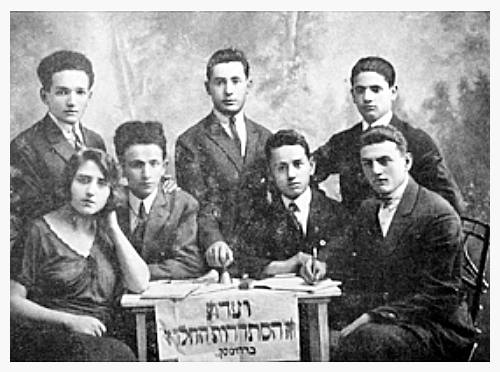
The committee of the “HeChalutz” organization in 1925:
Standing (right to left): A.B. Eisen, A. Zipler, M. Schitenberg;
Sitting – Y. Weintreter, Y. Lieberman, C. Goldberg, Yetta Silberstein
Every day we would gather at the Zionist synagogue, “Beit Ya'akov”. The owner of the house, David Barginsky, did not receive us kindly. The truth is, that we were not the most comfortable tenants. We were young and lively, and when we met on Shabbat afternoons, we would sing and thereby disturb the rest of the owner of the house, whose apartment was next to the synagogue, and the rest of the neighbors who lived nearby. Our main activity on Shabbat was cultural work. We bought the newspaper of HeChalutz – “HeAtid” (the future), and pamphlets and read in the books in Hebrew we received about the labor movement in Israel. After that came the singing, dancing, and going out into the surrounding forests. It required quite a bit of courage and daring from the girls of the city to join us. The first group of female members who joined included: Sheindel Grossman, my sister Chaya Pesia Goldberg, Chaya Silberstein (lives in Brussels), Ita Zelikovich (lives in Paris), Esther Elboim, Gitel Gelbert, Sarah Alpert (lives in Israel) and Billa Pariz. In a later period, Shifra Wittenberg (lives in Israel), Sara Devner (died in Israel), Gitle Davidovitz (lives in Israel), Rivka Lushchnowski, Esther Lustiger, Feigel Boko, Madja Patsnowska (lives in Israel), Sarah Glicksman (lives in Poland), Malka Fajerman (lives in Israel), Etke Moskovitz (lives in Israel), Frimit Bozhkovsky (lives in Israel), Hanke Gelbert, Pearl Goldstein and others joined us.
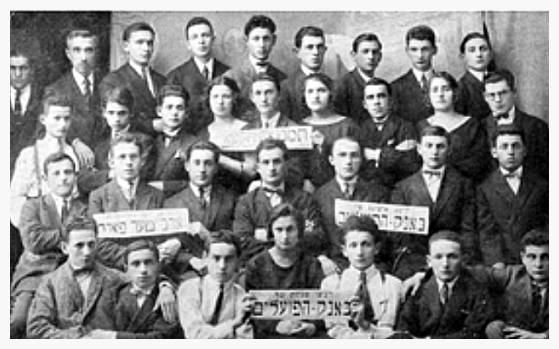
The first photograph of the Histadrut “HeChalutz” in 1924
First row from the bottom (right to left): Meir Putoshewitz, Moshe Schitenberg,
Chaim Goldberg,
Sheindel Grossman, Yehuda Lieberman, Shraga Bugeisky, Moshe Kamelgarn:
Second row: Fayvel Luria, Yitzhak Weintreter, Berl Brunner, Avraham
Rosenblum,
Aryeh Zipler, Yitzhak Karp, Asher Zimberknop;
Third row: Moshe Yitzchak Schitenberg, Chaya Zilberstein, Yitzhak Bugeisky, Itke Zelikovich,
Yitzchak Blum, Chaya Pesia Goldberg, Tuvia Weisberg, Avraham Bonim Eisen,
Avraham Dudkevich.
Fourth row: Mordechai Strasberg, Sander Kamelgarn, Shmuel Neiman, Chaim Wittenberg,
Yaakov Grossman, Meir David Goldberg, Hanoch Reich, Meir Volkowitz, Pinchas Kuperwasser.
The worshipers at “Beit Ya'akov” reminded us more than once: Is it
possible to have boys and girls together? We had one answer: we are preparing
to immigrate to Eretz Israel, and indeed it was enough to forgive us. On
Shabbats we would go out to the surrounding forests, Zachsovek Polbarki. We
trained ourselves to walk in an orderly manner, accompanied by Hebrew songs,
when we are helped by individuals, older than us, from the “Hashomer
Hatzair”. The march in the surrounding forests, which was inhabited by
pure Christians, aroused great curiosity. It was common to see a walk of a boy
and a girl who left the city for fear of the evil eye, and here were whole
groups of boys and girls, singing in a foreign language (Hebrew), walk around
with no fear of the dogs and neighbors and they learn to march like soldiers.
When it became clear to our neighbors that these groups were preparing to leave
them and immigrate to Israel, they felt relieved. I remember a special meeting,
with many participants, in the Polbarki forest, where we heard a report from
the fourth conference of “HeChalutz” held in Warsaw in 1925. Aryeh
Zipler and Avraham Rosenblum from our branch participated in that conference.
At the meeting, information was given about the establishment of training
groups and the possibilities of immigrating to Israel.
In November 1924, Avraham Anker, who was close to “HeChalutz” and founded a training group on his estate Lankaba, was murdered in the forests of Kaminsk. His father wanted to perpetuate his son's memory and expanded the training kibbutz, which was called Tel Avraham, to Garbek and Ozga. Chalutzim (pioneers) from all over Poland gathered there and worked in the fields and in cutting trees in the sawmill. The members of the branch in the city started visiting these kibbutzim and saw up close what life in training means. These visits had a great impact on the members of the branch.
Low period came for Zionism and the “HeChalutz” movement, with the reduction of immigration and various decrees, and there were no imminent prospects for improving the situation. The “HeChalutz” branch suffered severe shocks; Some of the youth sank into despair and there were also those who changed their opinions and moved to anti-Zionist movements. The “HeChalutz” branch was indeed non-partisan, but when “Tze'irei Zion”, S.Z party, was founded and after it united with the right wing of Poalei Zion, and the united Poalei Zion party was founded (S.Z), we made sure to include all members of the branch in the political framework. We left “Beit Ya'akov” and moved together with the united party to the club at 26 Przedbórzka St., in the house of Binyamin Holzberg. The joining of working boys to the “HeChalutz” required us to take care of their professional problems. And most of the professional associations were, as we know, under the influence of anti-Zionist parties. We had to be vigilant and protect the youth's soul. We thought it was very important that the members of the “HeChalutz” will be organized in the Socialist-Zionist Party. In a later period, the united party began to gain influence over the trade union, and established a number of its own trade associations – we were helped in this area by the “HeChalutz”. At that time, we aroused quite a bit of irritation in the hearts of our opponents because of the participation of “HeChalutz” members in the May Day demonstrations, in which we often marched together with the Polish Socialist Party – P.P.S. With slogans about the Land of Israel and Hebrew poetry, even the general Zionist circles started to suspiciously mention our connection with the Polish labor movement.
And so, we became one of the main subjects of Zionist action in the city. I remember how we took advantage of the visit of Uri Zaslavsky from Nahalal and Dr. Tarlo for a great revival of Zionist action. We were active in the work of the Jewish National Fund. We collected donations and sat at the bowl table in the synagogues on the eve of Yom Kippur. We actively participated in collecting funds and distributing the blue box. We collected donations at every wedding in the city (more than once we encountered such a warm “reception” that we barely managed to escape). In the month of Elul, we would go to the cemetery with the blue box to collect pennies from those who came to pay respects to their loved ones (we received “blessings” from the beggars, who saw us as their competitors).
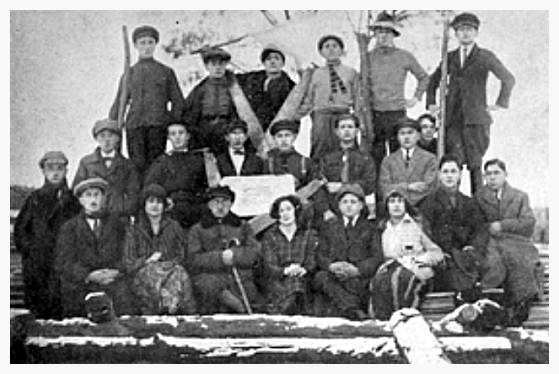
A group of “HeChalutz” members
in “Tel Avraham” training,
in the Lankava estate near Kaminsk (1924)
We were among the activists in the organization of the magnificent Bazaars,
which were among the largest in Poland, and were headed by Rabbi Yitzchak
Lachman (in Israel). In an earlier period, with the establishment of the Jewish
National Fund Battalion, we acted in it with all our might.
We were also active in Keren Hayesod and made ourselves available to the local committee.
We were almost alone in the action in favor of the “HeChalutz” Fund. In this area, all the action was incumbent on us alone. The first action was the visit of the member Y. Barginsky, in 1924, with the aim of collecting building materials which were intended for building in Ozga, in Kibbutz “Tel Avraham”. I remember those visits to the rich of the city, owners of factories, sawmills, forest merchants and more. Except for a few, they treated us in a shameful way. We organized a big garden ball in the lot next to the municipal cinema, which gathered around it the youth from the city and the surrounding area. People arrived to the ball even from Czenstochov and Piotrkow, and the ball became a great event and we raised a decent income for the “HeChalutz“ fund. We often organized flower's days. We were visited by the emissaries of the Land of Israel in the affairs of the “HeChalutz“ fund. Among these emissaries were the members Avraham Kanaani, Yehuda Koplowitz, Pinchas Rashish, Yitzhak Font, the lalte Shmuel Hafter and others. In these actions, we were helped by members of various Zionist parties which were associated with the “HeChalutz“ operation, among them Meir Volkowitz, Yaakov Wittenberg, David Haschavtsky, Shmuel Lachman (lives in Israel), Mendel Finzilber, Chaim Kreindler (lives in London), Wolf Shapira, Yosef Zeligzon, Yaakov Eichner, Yitzhak Farbman, Dr. Yaakov Aharonovitz and others. At the head of the operation of the “HeChalutz“ Fund were for many years the members Yehuda Lieberman and Moshe Schitenberg. Of course we were active in the “Kupat Poalei Eretz Israel” (the fund of the laborers of Eretz Israel) and later in the League for a Working Eretz Yisrael. The actions in the league were coordinated by the members Yaakov Lieberman, Leibish Mendel Lyman and Fayvel Luria. In the elections for the Congress of the Working Eretz Yisrael in Berlin, in 1929, about a thousand voters participated. The united party together with the “HeChalutz“ received over 700 votes.
At that time, many went to training groups. In 1927, Yehuda Lieberman went to
training in Brivinov, an agricultural estate near Warsaw. The first three who
went to Kolosova were the members Yaakov Shmuel Moshkowitz (lives in Israel),
Tuvia Mendel, Binyamin Stein (lives in Israel).
[Page 190]
The following members came right after them: Avraham Shmulevich (lives in
Israel), Shifra Wittenberg (lives in Israel), Gitle Davidovitz (lives in
Israel), Medzhia Patznowska (lives in Israel), David Fishman, Sarah Glicksman,
Yitzhak Gutesman, Malka Fajerman (live in Israel), Yosef Dudkewitz, Shmuel
Glicksman (lives in Israel), Shlomo Teichner, Simcha Reich (lives in London),
Daniel Eichner, Shmuel Dimant, Nathan Zilberstein, Sarah Devner, Wolf
Shimonovitz, Chona Segal, Peshrovsky, Hershberg, Mendel Fajerman and many
others whose names I can't remember. When these members would return for a
short vacation, they would bring them with them the special way of life of
their training groups and of course they were a lot of dancing and singings.
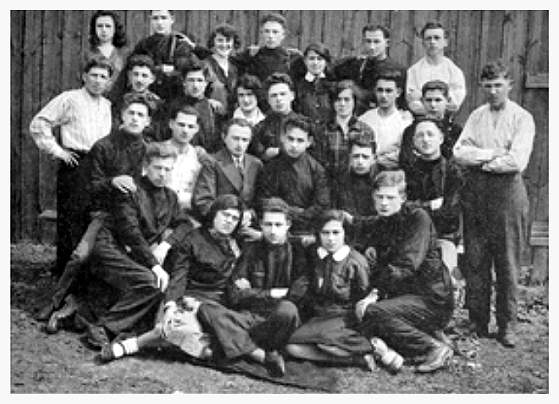
During the farewell party for Yehuda Lieberman's departure for training (1927)
First row from top (from right to left): Avner Gurfinkel, Y. Weisberg, Leah
Glicksman,
Gershon Goslavsky, —, V. Herbert, Y. Aza;
Second row: Wolf Brenner, Moshe Lieberman, Dov Kuperwasser, Simcha Reich, —,
David Widislavsky, Shifra Wittenberg, Pinchas Lieberman, Daniel Eichner, Binyamin Stein;
Third row: Asher Grossman, Yaakov Widislavsky, Yehuda Lieberman, Prof. Israel
Bromberg,
Yaakov Lieberman, Yosef Dudkevich;
Fourth row (from the bottom): Israel Fishlevitz, Sarah Glicksman, Yitzhak Gutsman,
Miriam Patznowska, Shaul Karp (died in Israel).
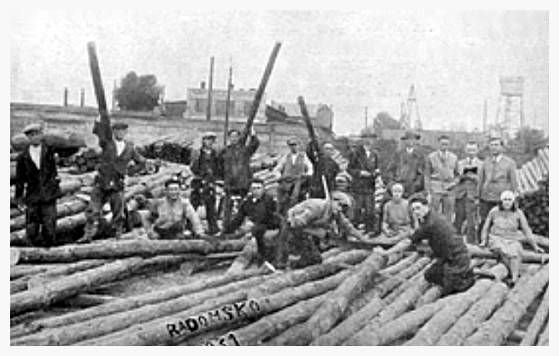
A training group of “HeChalutz” at Yitzhak Farbman's sawmill
For the entire time of the “HeChalutz” existence, we paid special
attention to learning Hebrew. Unfortunately, there was no Hebrew school in our
city and we tried to fill the gap by evening classes. The teachers were David
Haschbetsky, Mrs. Sternfeld, David Erlichman, Leah Talman Birnbaum (lives in
Israel) and Pnina Blum. In a later period, we held joint evening classes for
“HeChalutz” and “Freiheit” by Pola Fajerman (lives in
Israel). Hundreds of teenagers studied in these courses. We also held various
classes and the cultural activity was very extensive, especially on Shabbat
nights. In the cultural activity we were especially helped by Y. Aryeh Zipler
and in a later period by Prof. Israel Bromberg. In this area the club played a
valuable role. It was a lively center for singing, dancing, studying and
conversation. In the summer they would spend their Shabbats outside the city,
and in the winter the club was our favorite corner. It was not easy to receive
this club; Apart from the large financial expenses, we encountered difficulties
in renting an apartment due to the noise and commotion we would create. We
were, therefore, forced to wander from place to place: from “Beit
Ya'akov” to Holzberg's house at 26 Przedbórzka St., to Mitlitz at
Czestochovska St., then to Shapira's house on 1 Bezhezhnitska St., Goldberg's
house at 40 Raymonte St., and lastly – at Wilhelm's house at 5 Market St.,
the house of Chaim Galbert.
The relationship between the members of the “HeChalutz” and their parents was a special problem. Not every family looked at us favorably. We were usually treated well in the homes of poor children (and these were the majority), they were happy when we sent their children to training and after that we brought them to Israel. The situation in the wealthy homes was different, and sometimes they considered us as the main reason why their sons and daughters left the religious way and “fall into bad ways”. Many parents supported us and gave us a lot of help in the “HeChalutz”. One of the homes that became full partners in the life of the branch was my parents' house. Three of the four children in the house were in the “HeChalutz” and my parents not only put up with this situation, but also became loyal helpers to everything we did. The pioneers from the Ozga Garbek training camp spent weeks at our house. When a member got sick, he stayed in our house and left only after he recovered. Also, the members of the branch and emissaries from the “HeChalutz” center as well as the emissaries from the Land of Israel would stay with us. The second house or rather the “courtyard of the house” was the courtyard at 10 Przedbórzka St., the Ochkovsky's house, where Yehuda Lieberman's parents lived. There, too, five children from the house belonged to the “HeChalutz” branch, our youth movement, with the parents often helping us in our activities, and the courtyard becomes a center of activity. I remember that often, when we returned from the “HeChalutz” club, we would enter the courtyard, sit down on the iron bench around the big tree and continue the conversation that sometimes was also accompanied by singing. Many of the members of the “HeChalutz” lived in the same courtyard: the brothers Yaakov and David Wideslavsky, Yechezkel and Avraham Dickerman, the sisters Gitel and Hanna Gelbert, the sisters Leah and Gitel Wideslavsky, Yaakov and Asher Grossman, Hanoch Zalman Zuckerman (lives in Israel) and Avner Gurfinkel. It is therefore no wonder that the courtyard was an integral part of the branch. We were also helped by Moshe Schitenberg's parents. His father, grandfather and two uncles were from the “Mizrachi” founders in the city, and the “HeChalutz” was was very familiar to them. It should be noted that the branch in Radomsko was a center for the entire surrounding cities and towns; Youth from nearby towns and villages registered in our the “HeChalutz” branch and was sent by us for training, since there were no “HeChalutz” branches in small places. In the first period, people from the city of Przedbórz also registered in our branch, and only later an independent branch and a training kibbutz were established there.
During the great influx to the “HeChalutz” movement (1929), when they
set out to establish training kibbutzim in Polish towns, Radomsko was one of
the first cities to establish a training group. Boys and girls from all over
Poland arrived in leather jackets and big boots to a low wooden house.
[Page 191]
Their first place of residence was at the Meitlich flour mill on Czenstochowska
Street, a street where most of the residents were Christians, and in a small
room that had previously been used as the meeting place of Hashomer Hatzair.
They arrived exactly on the holiday of Purim and the members of the branch took
cakes from their homes (my mother also gave me the “Zuckerkochen”
that she made for Purim) and on the first evening we went to their place. The
first acquaintance was made by dancing and singing and the very next day –
new faces were seen around the city, boys and girls speaking a little Hebrew
about one topic – work. The first to receive five pioneers to work in the
sawmill was Yitzhak Farbman, born in Minsk Mazowiecki, who greatly helped the
training kibbutz. The Jews looked at the special wonder – dozens of young
men and women living together in conditions of famine; They do not shy away
from work and accept everything with love. This time the Jews of the city
accepted the establishment of the training kibbutz with sympathy and employed
the pioneers in whatever work was available to them. They were accepted in the
sawmill of Gittler Krakowski, Zygmunt Horowitz, in the “crystal”
glass factory of Yitzhak Fajerman and Mordechai Goldberg, in the brick industry
of Shmuel Meir Fajerman (in a later period they were given several rooms for
living there), in the factories of A. M. Shapira (metal), Y. Rosenbaum
(furniture), Moshe Fajerman, Yehuda Hersh Tiger, Kuperstuch (buttons), Y.
Grunis (cigarettes), Avraham Shlomo Hampel (candles). The pioneers were also
engaged in night watch and all kinds of casual jobs. There were also difficult
times and lack of work and we read about them in “Unzer Freiheit”,
(February 3, 1933), in the list written by Beinish:
Translated by Gloria Berkenstat Freund
The sawmills rest. Unemployment, eeriness in the agricultural collective
communities. All worry: Where does one get work? What more will happen?
Concern for the survival of the collective community rules everyone.
Conversation. The group thinks: How do we crawl out of this situation.
Yehiel: Turn to the masses. They, the masses, will never abandon us. The masses
understand us.
Announcements at the halls. We read and comment. One regrets: Such genteel
children drag water. What will the world say to this?
Another one: We are not permitted to do this, that people should fall so “low.”
Young men walk through the courtyards with belts buckled around them. “Is there water to carry here?” “No.” The young men hurry to the buckets. “Your buckets are empty; you do need water!”
No! No! I cannot watch you be so lowered.
Not true! Work is not a disgrace. An elevation! An elevation!
A sponsorship was also created and the kibbutz used it at various times,
especially during times of unemployment and financial crises (and there were
many of them). The living spirit in extending help to the group were the
brothers Shmuel and Yitzchak Lachman (live in Israel), Yaakov Eichner, Chaim
Kreindler, Moshe Yitzchak Shita and others. I will also mention Dr. Yaakov
Ahronovitz, and in a later period Dr. Simcha Hampel (lives in Israel), who made
themselves available to the group and took care of the health of the sick
members.
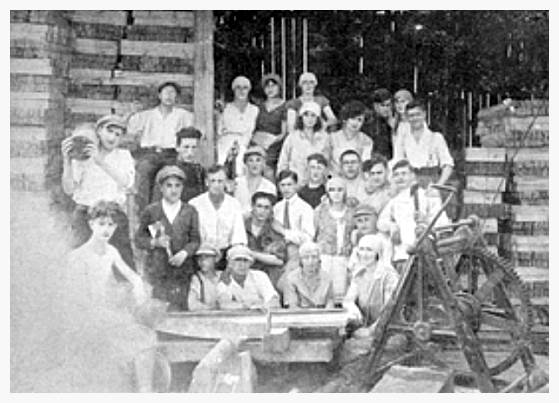
A training group of pioneers during a breaktime at the sawmill
Dozens of members went through the training in Radomsko. The
“HeChalutz” branch in the city was helped a lot by the group's
members, many of them participated in the management of circles and propaganda.
Every evening the members of the group would visit the branch and on Shabbats
the members of the branch would go out to visit the members of the training
group. This is how close ties were formed and the place of the group became a
bustling center, from which sounds of singing and dancing always blared.
In 1935, the second shift received the responsibility for the affairs of the “HeChalutz” in the city. Yehuda Lieberman immigrated to Israel in 1933 and the writer of these lines was called to be the secretary of the united party in Warsaw. The whole operation fell on the shoulders of members Eisen, Moshe Schitenberg, Tuvia Borzykowski (died in Israel), Yaakov Lieberman and Shmuel Nieman. In 1935, Schitenberg immigrated to Israel as well. Eisen started a family and livelihood concerns prevented him from devoting himself to the affairs of the movement as before. Then the movement's activity moved to a third shift: Tuvia Borzykowski, Yaakov Lieberman, Sinai Okrant (lives in Israel), Lazer Hoftman, Zvi Tzipler (lives in Israel), Granek Shimshon (lives in Israel), Avraham Dickerman and others.
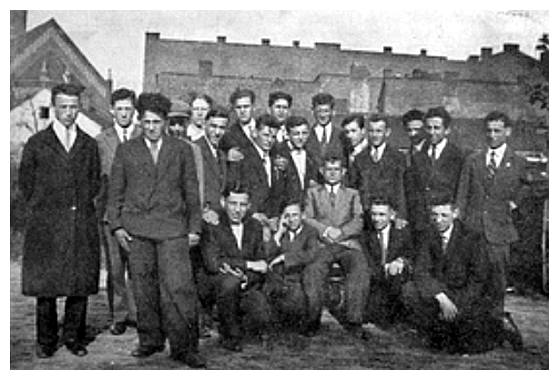
The participants of the Hebrew courses on behalf of the Histadrut
“HeChalutz” in 1928
(the teacher D. Erlichman sits in the middle)
In conclusion – the “HeChalutz” movement was always a vigil and
vibrant movement in our city. It enriched the youth's life and gave them a
reason to live. It had a decisive influence on the youth in the city and even
in the surrounding area and it was an educational institution for the youth.
Here the youth received the socialist Zionist concepts, which determined his
path in life. We cannot describe our city without the “HeChalutz”
movement. We have made the city Zionist. We have injected a spirit of life into
it, with the “HeChalutz” movement serving as a cornerstone for
Zionism and laying solid foundations for the building of a life of work and
creativity in the homeland.
by Miriam Patznowski (Krakover)
Translated by Mira Eckhaus
The Hashomer Hatzair movement had success among the Jewish youth in Radomsko.
This was preceded by a scouting movement in the years of the First World War,
which transformed over the years from a neutral scouting movement into a
Zionist youth movement, whose goal was to educate the youth for a new life in
our old new homeland – the Land of Israel. The task was not easy. Indeed,
the Zionist movement was known on the Jewish Street in our city, but the belief
in the realization of the vision was weak. Zionists were ready to collect and
give money, make donations and dream of their new country that would give them
the right to be an equal nation among all nations, but to educate their
children for a new life in a free land, this required a revolutionary step in
their private lives. Our movement also encountered obstacles of this type. A
significant part of the residents of our city were ultra-Orthodox Jews who
raised their children in the spirit of tradition and forbade them to be
interested in things that were outside of their educational scope. On the other
hand, there were those who assimilated, whose goal was to be assimilated
without wanting to predict what was expected to them in the future. Despite
everything, the Hashomer Hatzair youth movement arose in this environment. The
learning youth gathered around the instructors who knew how to get them carried
away at a young age.
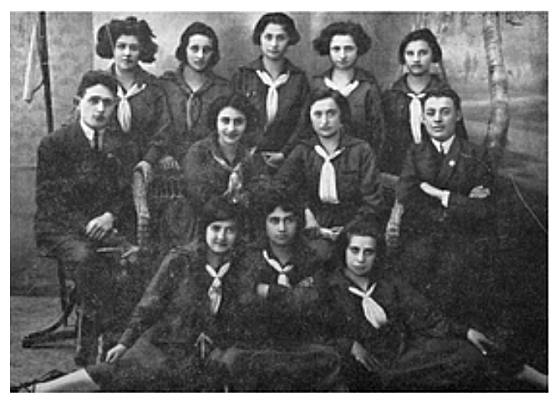
A group of instructors of “Hashomer Hatzair” (1925)
First row above (from the right): P. Hofman, M. Waxman, Yadzhe Bugaiska, R.
Katz. H. Silberstein
Second row: A. Y. Cohen, P. Silberberg, A. Levkowitz, D. Bugeisky
Third row: T. Kamelgren, F. Cherta, S. Glicksman.
I remember, when I was about eight or nine years old, in the first class at the
gymnasium, one day H. Wittenberg and others appeared in the school and invited
us to their nest. Singing, dancing and walks in nature attracted our young
hearts, since the joy and freedom were missing for our people in exile. During
the following years, they emphasized the value of studies and cultivated in us
a desire to know and explained us things in many areas. They taught us to see
life in a different light, to read a suitable book and to understand the
meaning of various phenomena in our daily life. They instilled in us the love
of nature, the knowledge of animals, the value of man and the importance of
mutual help which was sometimes necessary even among the children. They also
cultivated in us a self-criticism that required us to always acquire more
information. I had a feeling of happiness that my friends at school, who didn't
extend their horizons outside the study area of the school, were not familiar
with. We, the members of the movement, were bonded with a vision, that was
perhaps distant in terms of execution, but very close to our hearts. Hebrew
poetry, Land of Israel dances, knowing nature, cultivating self-respect and
nationalism gave us courage to dream at the time and then, when the time came,
to fulfill our ambition. We spent all our free time in the nest and felt as if
it was a warm home, full of understanding and spirituality. I still remember a
few instructors: Wittenberg Herschel, David Bugeisky, Wilonski, Haza, Yaakov
Eichner, Lola Zasharski, Litman, A. Y. Cohen. In the course of time, many left
and some were recruited into the army and thus, the operations were reduced. We
collected money among the members in order to maintain at any cost the
possession of the club that was at Mitlitz's house, far from the city, in the
Christian quarter (on the way to Zakshubek). In recent years, access to the
club was dangerous due to the increase in anti-Semitism, but the danger did not
prevent us from visiting it even in severe frost. I remember that we studied
and read Shalom Aleichem with Misha Cohen (who was at the time our instructor)
and we did not feel the great frost that was there, since for several hours we
were so eager to gain knowledge that we ignored reality.
When I got home, I felt like my legs were half frozen. I was very grateful to
Misha that, at any cost, we acquired knowledge of Yiddish literature (reading
Yiddish was a bit difficult for us and this meant giving up reading several
books in Polish) and we began to get to know the life of the working man and
his problems. Over time we grew up and the yoke of the nest fell on us. We
began to take responsibility for younger children and educate them in our
spirit for our purpose. The club was given to the “HeChalutz” because
of the reduction of our ranks and we wandered from place to place. We once had
an apartment at a Christian lady's house on Czestochowska Street and once on
Railway Street, between times we would have conversations on the steps of all
kinds of public places away from the city, since gatherings were forbidden in
our city and we had to stand guard and run away when the police showed up.
[Page 193]
A circle of workers joined our ranks, whose problems were reflected to us; We
also got to know the life of a Jewish worker. We would also meet at the
“HeChalutz” because a common vision linked us to work life in the
Land of Israel. We occupied an honorable place in Jewish National Fund –
we dedicated every evening to collecting donations and not even the most
difficult weather or the reluctant faces of the donors prevented us from doing
so. We should note Mr. Volkowitz, who was at the time authorized by the Jewish
National Fund and devoted the best of his time to this cause. After leaving
school, the “Hashomer Hatzair” group was organized under the guidance
of the Weintraub gymnasium, the teacher Israel Bromberg. There we studied the
literature of our people and thanks to that we started to know the problems.
Aharon Rotenberg, who that at that time studied and spent time in our city,
helped us quite a bit to stay in the movement for a long period.
After a while he returned to his town of Belchatow and the connection between the two nests was not severed. This situation continued until it was time for Sarah Glicksman and me to go to training. We were very sorry for this, because in our absence there was a danger that the nest of Hashomer Hatzair movement will fall apart. Only a few members of the Hashomer Hatzair movement in our city fulfilled their ambitions. The reason for this was that it was not easy to leave aging parents without the help of the sons, or that the means to immigrate were limited.
If they would have obeyed their hearts and did not have to consider the conditions of reality, many of them would have saved themselves from the destruction and the Holocaust.
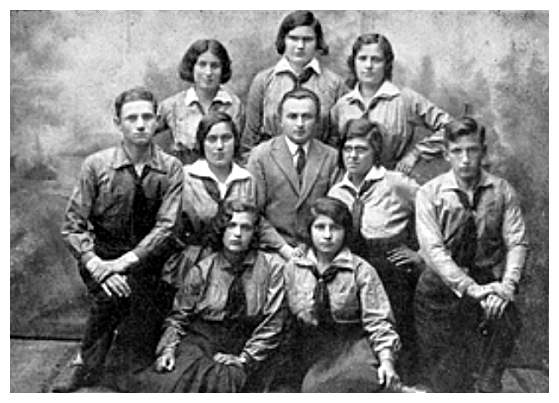
“Hashomer Hatzair” group in Mrs. Weintraub's gymnasium (1931)
First row above (from right): A. Warshavska, Malka Fairman, Rivka Bugeisky;
Second row: Shaul Blumstein, M. Patznowski (in Kibbutz Negva), Prof. Bromberg,
S. Glicksman, A. Zombek;
Below: G. Yakobovitz, H. Patznowski.
by Yitzhak Lachman
Translated by Mira Eckhaus
The bazaars for the benefit of the Jewish National Fund that were held in
Radomsko are still remembered by many of the people of our city. The bazaars
left a strong impression on their organizers and those who participated in
them, and the days they took place were the “Days of the Land of
Israel” for the Jewish population in the city and gave it a sort of
holiday feeling.
The main goal that the organizers of the bazaars was to collect funds for the Jewish National Fund, but at the same time they intended to make them a first class social and culture event for the city's Jews.
The preparations for the bazaars were large and included many of the loyalists of the Zionist movement in the city, from the Jewish National Fund activists to members of the various Zionist youth groups. The preparatory work began long before the opening of each bazaar. The members of the bazaar committee were engaged in collecting various goods and exhibits from the Jewish merchants and factory owners in the city. The Jewish merchants from our city also motivated factory owners, Jews and Poles, from other cities throughout Poland with whom they had trade relations, to donate their goods to the bazaar. The women and school students in the city also took pains to prepare their works for the bazaar, works that excelled in their beauty.
The great effort invested by the Jewish National Fund activists in the city and others in the organization of each bazaar and its planning bore its full fruit. The halls and the community board, where the bazaars were held, were full of joy, and from the impressive opening with the participation of the late member Avraham Bialopolski from Warsaw until the time of their final closing, they became a demonstration of love and affection on the part of the Jews of our city for the idea of the “redemption of the land”. The good atmosphere was enhanced by the varied artistic programs that attracted a large crowd. In these programs, the Hebrew Kindergarten performance of Mrs. Khaschevtsky was one of the most successful.
One of the successful bazaars was the bazaar held in 1933 on the Sukkot holiday. It was a wonderful idea to take advantage of the holidays to organize the bazaar when the townspeople are free from their business, the students are freed from their duties and everyone's heart is open to what is happening in the bazaar. In the year mentioned above, the bazaar was visited not only by the Jews of our city, but also by the Jews of the nearby towns who were present at the performances and conferences that were held. In the hearts of the bazaar organizers was the feeling that the decoration of the bazaar during Sukkot days added to the joy of the holiday of its visitors and hinted at the symbolic connection between the bazaar and the time it was held.
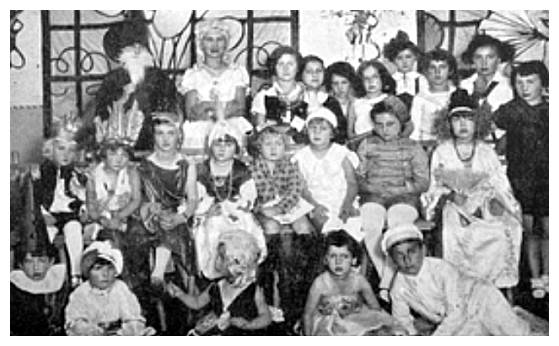
Children's performance in the Jewish National Fund ”Bazaar” market
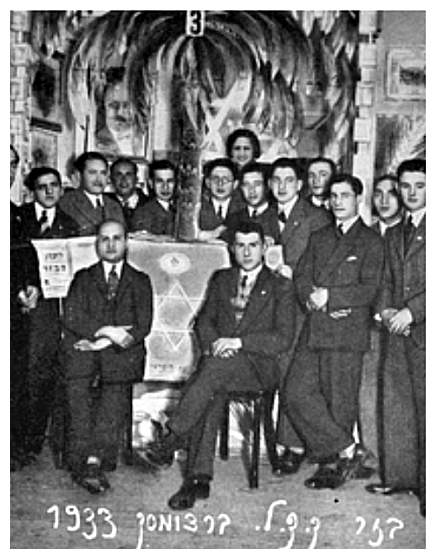
Next to booth number 3 in the Jewish National Fund “Bazaar” market
in 1933
The chairman of the bazaar committee gave expression to this feeling in his
opening remarks: “There is great symbolism in this bazaar held on the days
of Sukkot, – which are the days of Asif, in which our ancestors, the
members of the Jewish people who lived in their land and worked their land,
celebrated the festival of gathering the crops to their granary. So do we, the
Jewish people in the Diaspora, celebrates in this holiday the collection of
donations for the redemption of the land”.
Not less than the moral success was the financial success. The amount of money collected that year reached up to 2000 zlotys and exceeded the sums collected in other larger cities, such as Bialystok and Pinsk, whose income of their bazaars reached up to 1000-1700 zlotys only.
In bringing up these memories, I feel obliged to mention the memories of the members who took part in organizing the bazaars, as they were listed in the bazaar brochure published in October 1933 by the bazaar committee: Yitzhak Lachman, M. Volkowitz, Y. Zelikson, D. Khaschevtsky, D. M. Kornberg, H. Hartman, Mania Shapira, Mila Goldberg, A. Aharonovitz, Yaakov Eichner, M. Ofman, Dora Bogeiska, M. Banker, Dora Hartman, Salzman, Zacharanowitzka, Mania Grossman, Rivka Bialystok, Yaakov Markowitz, P. Sobol, Daniel Eichner, W. Kuperstuch, M. Hoffman, C. Moskovitz, Chaim Goldberg, Esther Firman, P. Gvozdze, M. Minsky, Brigel, Lipa, Truskolska, Pashirodska, S. Fairman, Y. Reinhertz. R. Robin.
The makers of the set: the painter Nathan Spiegel, the Langens, D. Wilonsky, b. Banker, B. Gesiksman, H. Zuberman, A. Grossman, S. Hartman, Shidlovsky, Seligfeld. Artistic performance: the members of the “Hachshara” (training) under the management of the member Karbel.
Many of these did not get to see the revival of their people in their homeland, to which they contributed their modest share. These lines will serve as a sign in their memory. The days of uplifting that they brought to the citizens of their city through their dedicated work will be remembered.
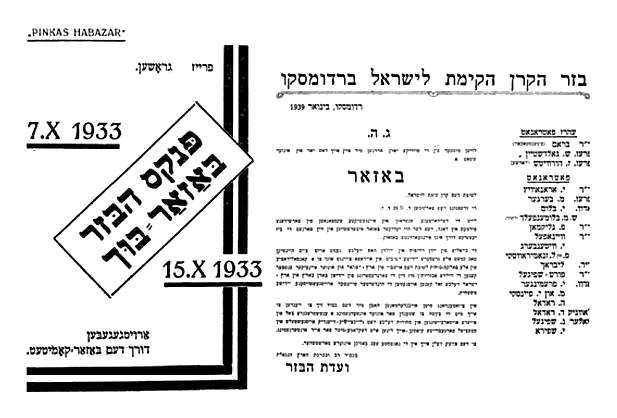
From brochures-prospects that appeared during the “bazaars”
|
JewishGen, Inc. makes no representations regarding the accuracy of
the translation. The reader may wish to refer to the original material
for verification.
JewishGen is not responsible for inaccuracies or omissions in the original work and cannot rewrite or edit the text to correct inaccuracies and/or omissions.
Our mission is to produce a translation of the original work and we cannot verify the accuracy of statements or alter facts cited.
 Radomsko, Poland
Radomsko, Poland
 Yizkor Book Project
Yizkor Book Project
 JewishGen Home Page
JewishGen Home Page
Copyright © 1999-2024 by JewishGen, Inc.
Updated 18 Jun 2023 by OR